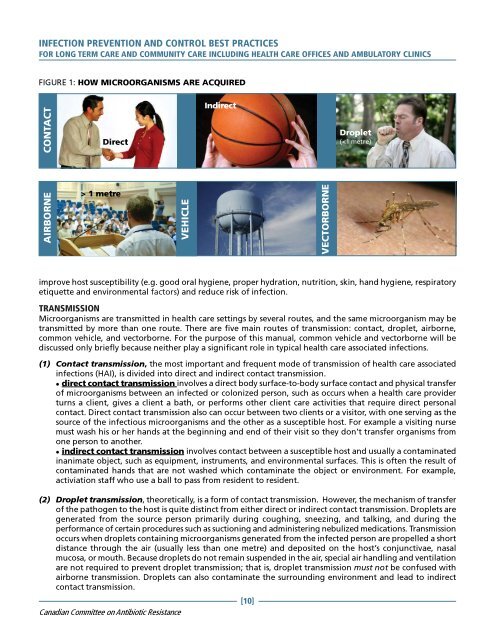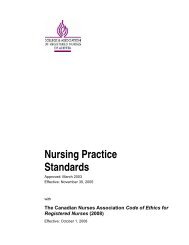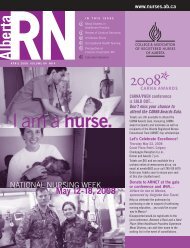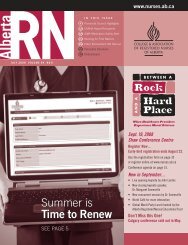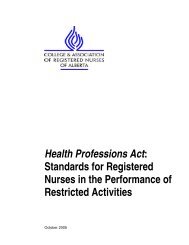Infection Prevention and Control Best Practices - College ...
Infection Prevention and Control Best Practices - College ...
Infection Prevention and Control Best Practices - College ...
You also want an ePaper? Increase the reach of your titles
YUMPU automatically turns print PDFs into web optimized ePapers that Google loves.
INFECTION PREVENTION AND CONTROL BEST PRACTICES<br />
FOR LONG TERM CARE AND COMMUNITY CARE INCLUDING HEALTH CARE OFFICES AND AMBULATORY CLINICS<br />
FIGURE 1: HOW MICROORGANISMS ARE ACQUIRED<br />
CONTACT<br />
AIRBORNE<br />
Direct<br />
> 1 metre<br />
improve host susceptibility (e.g. good oral hygiene, proper hydration, nutrition, skin, h<strong>and</strong> hygiene, respiratory<br />
etiquette <strong>and</strong> environmental factors) <strong>and</strong> reduce risk of infection.<br />
TRANSMISSION<br />
Microorganisms are transmitted in health care settings by several routes, <strong>and</strong> the same microorganism may be<br />
transmitted by more than one route. There are five main routes of transmission: contact, droplet, airborne,<br />
common vehicle, <strong>and</strong> vectorborne. For the purpose of this manual, common vehicle <strong>and</strong> vectorborne will be<br />
discussed only briefly because neither play a significant role in typical health care associated infections.<br />
(1) Contact transmission, the most important <strong>and</strong> frequent mode of transmission of health care associated<br />
infections (HAI), is divided into direct <strong>and</strong> indirect contact transmission.<br />
� direct contact transmission involves a direct body surface-to-body surface contact <strong>and</strong> physical transfer<br />
of microorganisms between an infected or colonized person, such as occurs when a health care provider<br />
turns a client, gives a client a bath, or performs other client care activities that require direct personal<br />
contact. Direct contact transmission also can occur between two clients or a visitor, with one serving as the<br />
source of the infectious microorganisms <strong>and</strong> the other as a susceptible host. For example a visiting nurse<br />
must wash his or her h<strong>and</strong>s at the beginning <strong>and</strong> end of their visit so they don’t transfer organisms from<br />
one person to another.<br />
� indirect contact transmission involves contact between a susceptible host <strong>and</strong> usually a contaminated<br />
inanimate object, such as equipment, instruments, <strong>and</strong> environmental surfaces. This is often the result of<br />
contaminated h<strong>and</strong>s that are not washed which contaminate the object or environment. For example,<br />
activiation staff who use a ball to pass from resident to resident.<br />
(2) Droplet transmission, theoretically, is a form of contact transmission. However, the mechanism of transfer<br />
of the pathogen to the host is quite distinct from either direct or indirect contact transmission. Droplets are<br />
generated from the source person primarily during coughing, sneezing, <strong>and</strong> talking, <strong>and</strong> during the<br />
performance of certain procedures such as suctioning <strong>and</strong> administering nebulized medications. Transmission<br />
occurs when droplets containing microorganisms generated from the infected person are propelled a short<br />
distance through the air (usually less than one metre) <strong>and</strong> deposited on the host’s conjunctivae, nasal<br />
mucosa, or mouth. Because droplets do not remain suspended in the air, special air h<strong>and</strong>ling <strong>and</strong> ventilation<br />
are not required to prevent droplet transmission; that is, droplet transmission must not be confused with<br />
airborne transmission. Droplets can also contaminate the surrounding environment <strong>and</strong> lead to indirect<br />
contact transmission.<br />
Canadian Committee on Antibiotic Resistance<br />
VEHICLE<br />
Indirect<br />
[10]<br />
VECTORBORNE<br />
Droplet<br />
(


